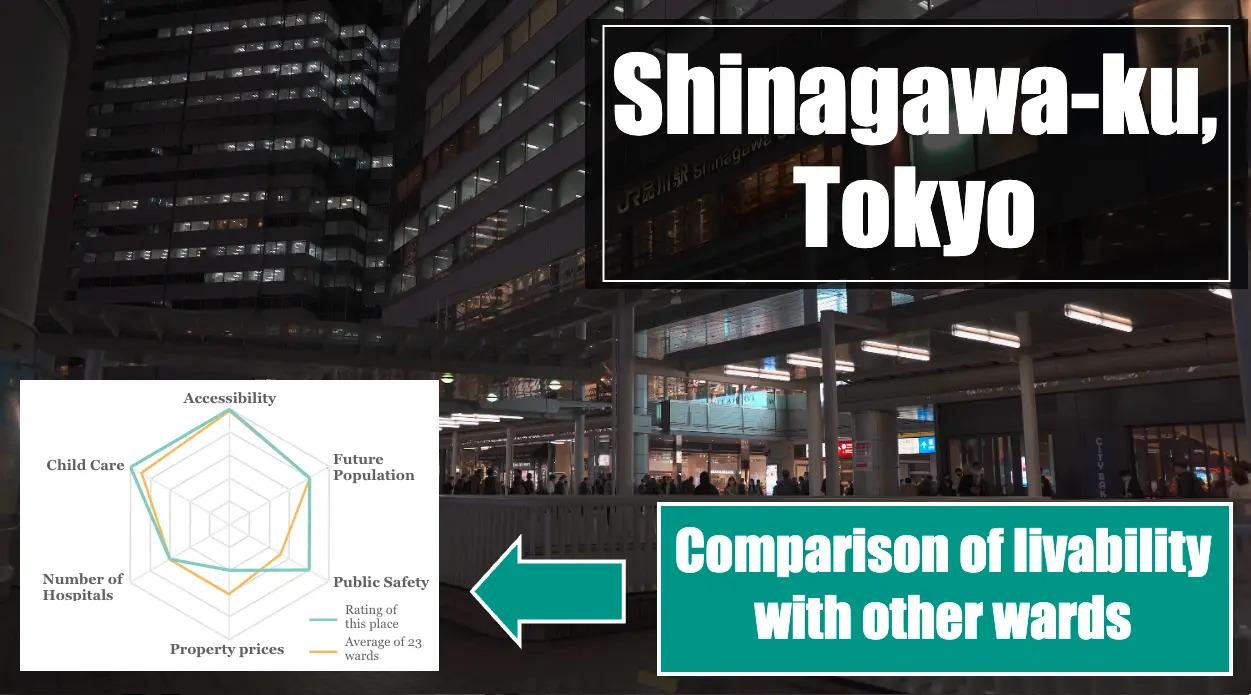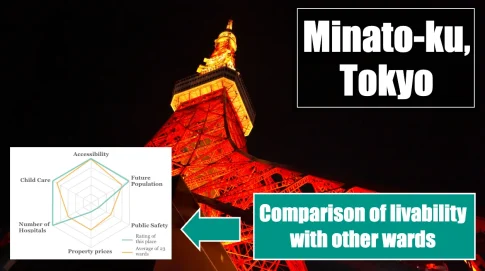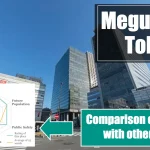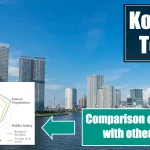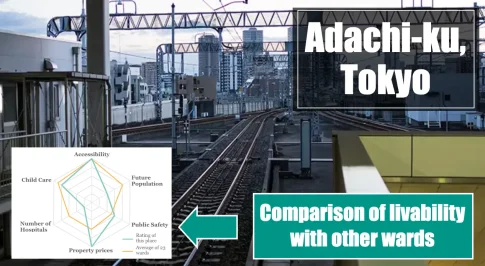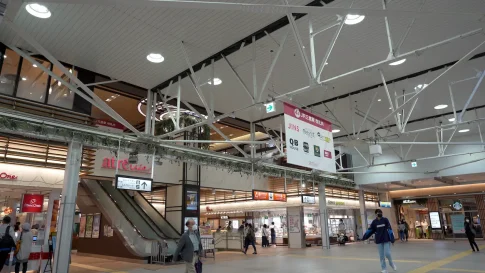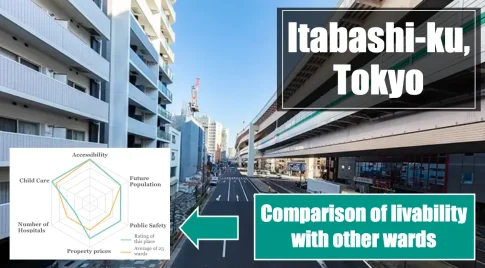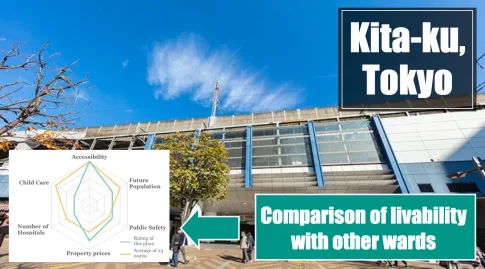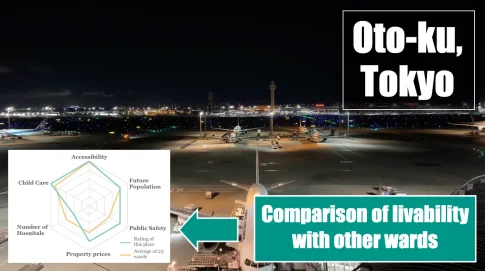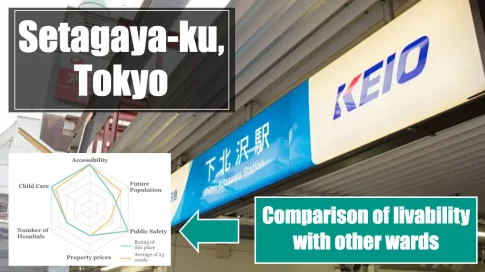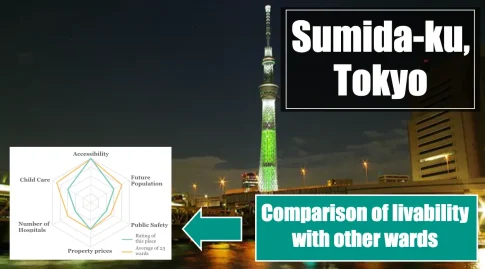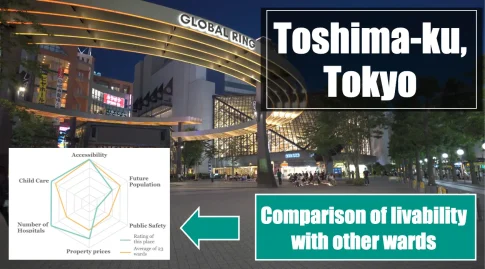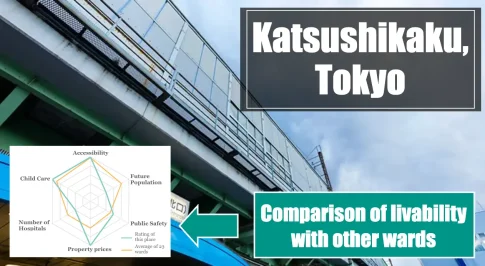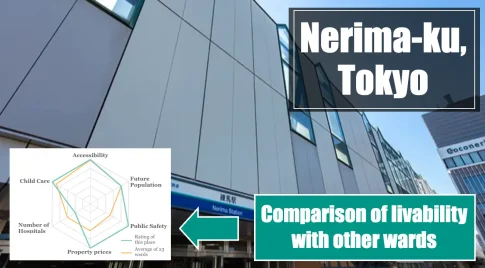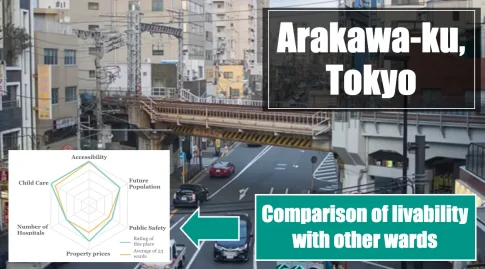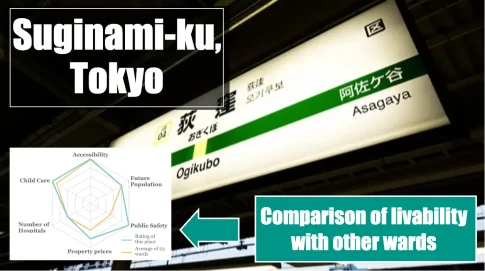This section introduces the livability of Shinagawa ward, Tokyo compared to the other 23 wards.
Contents
Livability of Shinagawa ward|First Conclusion
- Safer than other 23 wards in Tokyo.
- No. of children on waiting list 0.
- many slopes.
- High property prices.
Shinagawa Ward consists of a waterfront area facing Tokyo Bay and a mountainous plateau, and has long flourished as a transportation and trading center. It has long flourished as a transportation and trading center. The traditional atmosphere of the area can be felt in the streets of the former Tokaido Highway Shinagawa-juku, the temples and shrines, and the waterside space of Shinagawa-ura. Furthermore, the area also has a “new and progressive” atmosphere, such as the commercial areas developed around Shinagawa Station and the waterfront area.

To give you a brief idea of the livability of Shinagawa Ward, Tokyo, with these characteristics, it is a safe city with high accessibility and a rising population in the future. On the other hand, property prices are high.
Compare Shinagawa-ku with other wards
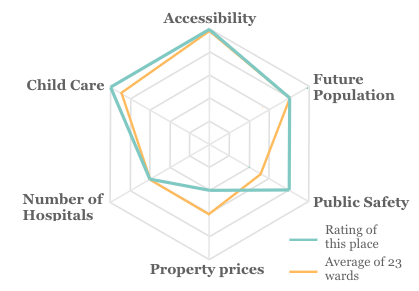
▼Accessibility
Calculated by the time it takes to get out to the Yamanote Line station.
5 = within 15 minutes
4 = within 20 minutes
3 = within 25 minutes
2 = within 30 minutes
1=more than 30 minutes
▼ Future Population
Calculated as percent change in population in 2045 relative to current population.
Over 110% = 5
Over 100% = 4
Over 90% = 3
Over 80% = 2
Less than 80% = 1
▼ Public Safety
The number of perceived crimes per 1,000 population is evaluated using the following criteria
5= less than 4 crimes per 1,000 people
4= less than 5
3= less than 6
2= less than 8
1= more than 8
▼ Property prices
Compared to the respective averages for rentals and condominiums in the 23 wards of Tokyo
5=30% or more reasonable price
4=10% or more but less than 30% of the price of the property
3=Less than 10% of the price before or after
2 = 10% or more but less than 30% more expensive price
1 = 30% or more expensive price
and then summed and re-evaluated.
▼ Number of medical facilities
(The number of medical facilities is evaluated against the average of Tokyo’s 23 wards (excluding extremely expensive wards) using the following criteria.
5=30% or more
4=10% or more but less than 30
3=10% or more, but less than 10%.
2=10% or more but less than 30
1=30% or more
▼ Child Care
The following criteria are used to evaluate against the number of children on waiting lists.
5 = 0 children on waiting list
4=Less than 5 children on the waiting list
3=Less than 10 children on the waiting list
2=Less than 50 children on the waiting list
1 = 50 or more children on the waiting list
Above, the green line is the valuation of Shinagawa Ward, and the orange line is the average valuation of the other 23 wards of Tokyo. Let us look at each of them in turn.
Accessibility of Shinagawa-ku
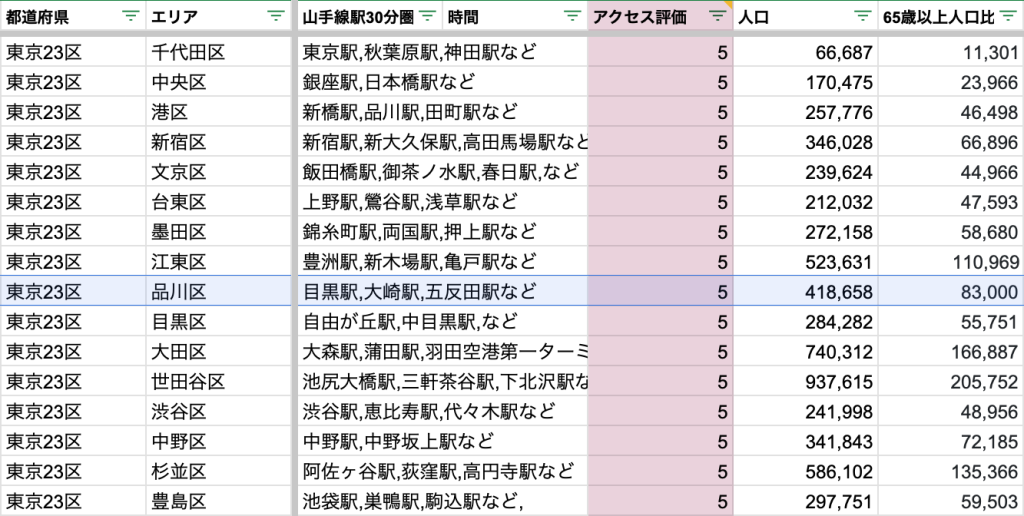
- JR Yamanote Line: “Osaki Station”, “Gotanda Station”, “Meguro Station
- JR Keihin Tohoku Line: “Oimachi” station
- JR Yokosuka Line: “Nishi-Oi” station
- JR Saikyo Line: “Osaki” station
- JR Sotetsu Direct Line: “Osaki”, “Nishi-Ooi” station
- JR Shonan Shinjuku Line (Takasaki Line – Tokaido Main Line): “Osaki” “Nishi-Oi
- JR Shonan Shinjuku Line (Tohoku Main Line – Yokosuka Line): “Osaki” “Nishi-Oi
- Keikyu Main Line: Kita-Shinagawa, Shin-banba, Aomono-yokocho, Samezu, Tachiaigawa, Omori-kaigan
- Tokyo Monorail: Tennozu Isle Station, Oi Keiba-mae Station
- Tokyu Meguro Line: Meguro Station, Fudomae Station, Musashikoyama Station, Nishikoyama Station
- Tokyu Oimachi Line: Oimachi Station, Shimojinmei Station, Togoshiginza Station, Nakanobu Station, Ebara-cho Station, Hatanodai Station
- Tokyu Ikegami Line: Gotanda Station, Osaki-hirokoji Station, Togoshiginza Station, Ebara-Nakanobu Station, Hatanodai Station
- Tokyo Metro Namboku Line: Meguro Station
- Toei Asakusa Line: Nakanobu Station, Togoshi Station, Gotanda Station
- Toei Mita Line: Meguro Station
- Tokyo Waterfront Area Rapid Transit Rinkai Line: Tennozu Isle Station, Shinagawa Seaside Station, Oimachi Station, Osaki Station
Shinagawa Ward has 16 lines and 26 stations.

The Tokyo Monorail provides access to Haneda Airport, and the JR Yamanote, Keihin Tohoku, and Yokosuka lines provide access to Tokyo and Ueno stations, which are Shinkansen stops, making it a highly accessible city compared to other wards.
Shinagawa-ku Population and Future Population
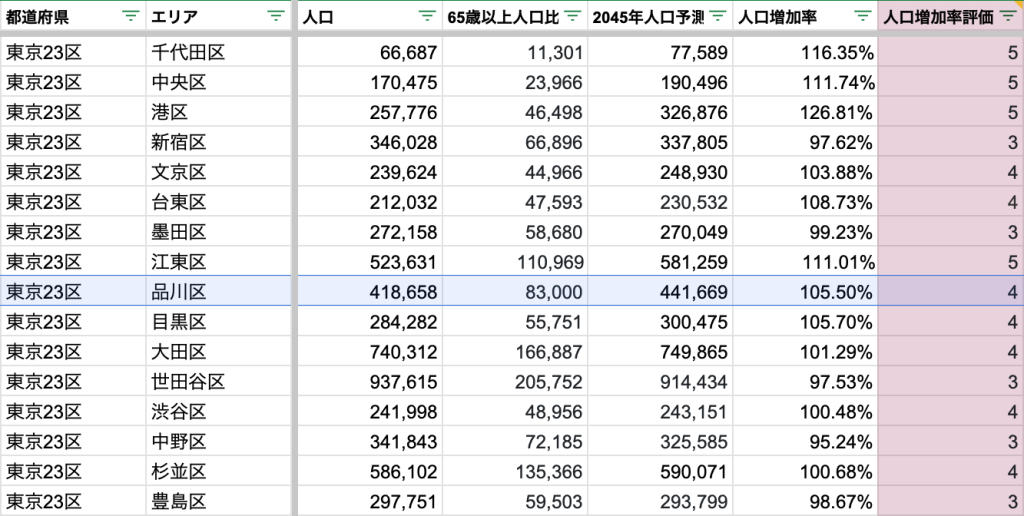
The population of Shinagawa Ward is approximately 419,000.
The future population in 2045 will be 441,669 (105.5%), an increase of 23,000 from the current population. This is an excellent figure for a 5.5% population increase in a time when the entire nation of Japan is projected to experience population decline.

Even within the same 23 wards, there are areas where population is projected to decrease. In contrast, the fact that the population is projected to increase will further increase the value of the city, for example, in terms of real estate prices.
Is Shinagawa city safe?
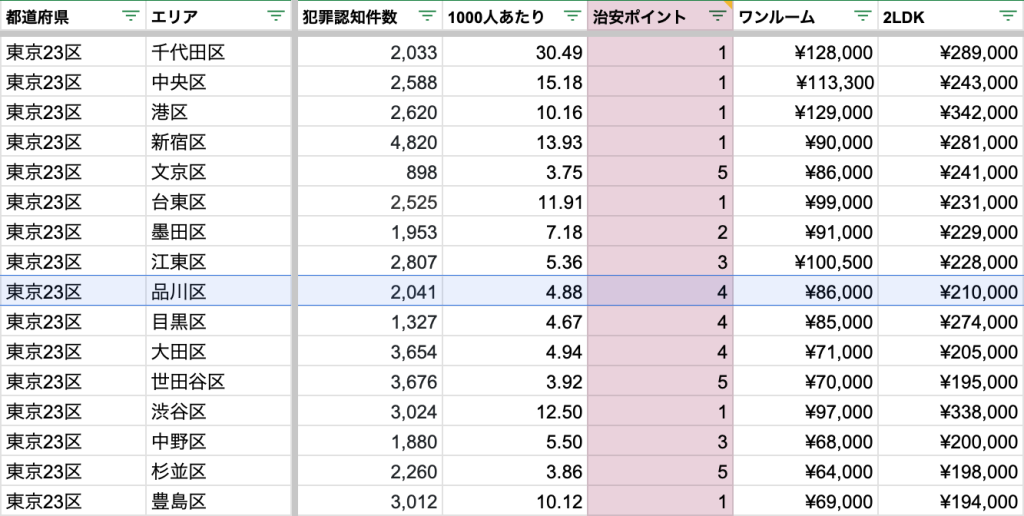
Compared to the surrounding wards, Shinagawa Ward gives the impression of being a “safe” ward.
The number of crimes in 2022 was 2,041, which is 4.88 crimes per 1,000 people in Shinagawa Ward.
Since the average number of crimes per 1,000 people in other wards is about 6 to 7, Shinagawa Ward was rated as “good” in terms of public safety.

Although the number of crimes in Shinagawa Ward is low among the 23 wards of Tokyo, special fraud and bicycle theft have been on the increase in recent years.
Property quotes in Shinagawa-ku
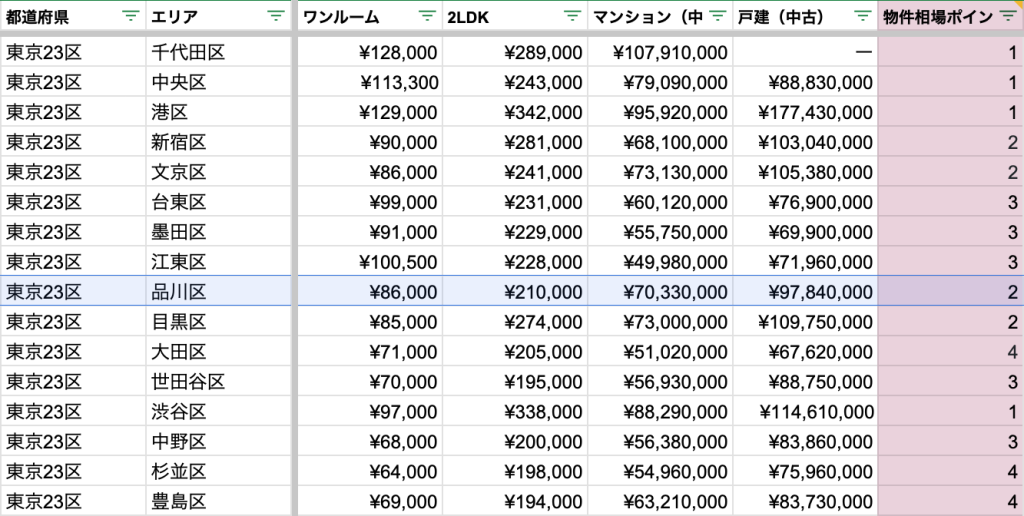
- One room rental = approx. 86,000 yen
- 2LDK rental = approx. 210,000 yen
- Condominium for sale = approx. 73 million yen
- Detached house = approx. 98 million yen
The market prices of properties for rent and for sale in Shinagawa Ward are shown above.

As shown in the table, compared to other surrounding wards, the property market in Shinagawa Ward was rated higher. Both rentals and sales will require a considerable amount of thought and effort.
Number of Hospitals in Shinagawa-ku

Shinagawa Ward has 452 hospitals and other medical facilities.
This is 1.08 per 1,000 people, which is an “average” level compared to the comparison target (a city outside the 23 wards of Tokyo where one can reach a Yamanote Line station in about 30 minutes).
Shinagawa-ku Childcare
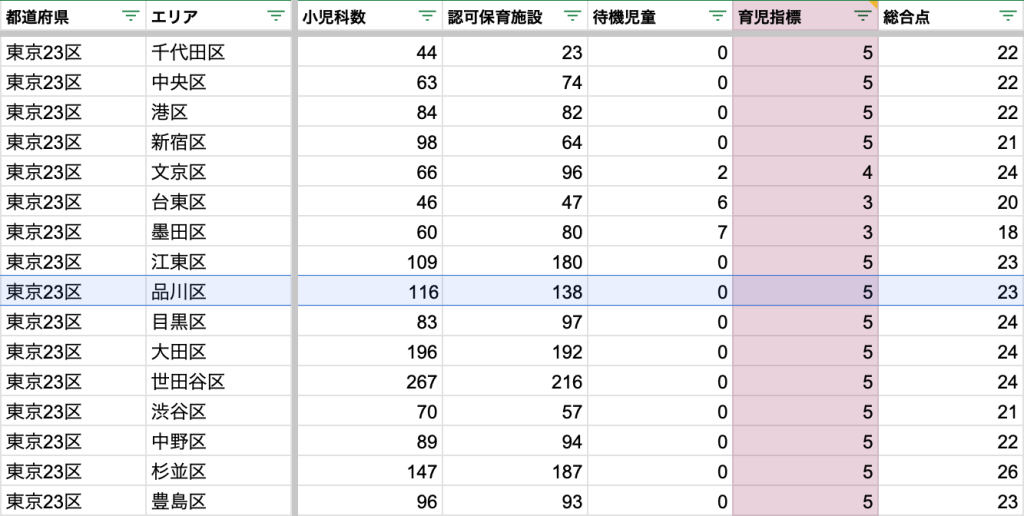
As for childcare, according to 2022 data, there were zero children on the waiting list in Minato Ward. In addition, there appear to be 116 pediatricians and 138 licensed childcare facilities.

There are wards within the 23 wards that have waiting lists for children. In contrast, Shinagawa Ward has 0 children, which is a great point for families who want to leave their children in the care of their children.
“待機児童=Taiki jidō” in Japan refers to children who need but can’t secure a spot in childcare facilities due to shortage. This is a major social issue.
What you need to know before moving to Shinagawa-ku

Here we report on the contents of the regional hazard measurement survey for earthquakes published by the Tokyo Metropolitan Government Bureau of Development.
The above figure is a color-coded chart of five levels of “overall risk” calculated from two factors: “building collapse risk” and “fire risk.
According to the chart, Shinagawa Ward has the lowest risk level from rank 1 (light blue area) to rank 5 (brown area).
The areas in Shinagawa Ward that are particularly high-risk (rank 5) are as follows.
- Futaba 3-chome, Shinagawa Ward, Tokyo
For more information, please visit the Shinagawa Ward page of the Tokyo Metropolitan Government Bureau of Development. If you are considering moving to Shinagawa Ward, we recommend that you take a look at this page.
Shinagawa-ku livability summary
- Good accessibility 【Good!】
- Population is expected to increase in the future 【Good!】
- Safety is good 【Good!】
- Property prices are high 【Bad!】
- The number of hospitals is average.
- The number of children on waiting lists is zero.
We checked the livability of Shinagawa Ward and found it to be as shown above.
It is safe and the number of children on waiting lists is zero, which is a good point. On the other hand, it should be noted that property prices are high.

CominWhy don’t you positively consider moving to Shinagawa-ku?
▼Population
https://www.metro.tokyo.lg.jp/tosei/tokyoto/profile/gaiyo/kushichoson.html
▼Future population
https://jmap.jp/cities/detail/city/13109
▼Public order
https://www.keishicho.metro.tokyo.lg.jp/about_mpd/jokyo_tokei/jokyo/ninchikensu.files/R4.csv
▼Market price of property
https://www.chintai.net/tokyo/area/13100/rent/1r/
https://www.homes.co.jp/mansion/chuko/tokyo/koto-city/list/
https://www.homes.co.jp/kodate/chuko/tokyo/23ku/city/price/
▼Taiki jido
https://www.hokatsunomikata.com/taiki_infos/636
▼Number of Hospitals
https://jmap.jp/cities/detail/city/13109
▼Number of approved childcare facilities
https://www.fukushi.metro.tokyo.lg.jp/kiban/fukushi_shisetsu/shs_list/202305.html
▼Tokyo Earthquake Hazard Level
https://www.toshiseibi.metro.tokyo.lg.jp/bosai/chousa_6/9shinagawa.htm
▼Other cities
Minato-ku, Tokyo. Survey of livability in Japan
▼Other Languages
港区は治安悪い?やばい?住みたくない?他の東京23区と魅力や特徴比較
The information published on this site is the data at the time of the survey. Therefore, please be sure to check the latest data by yourself.
